The best seven-seat cars: driven and ranked
Family haulers aren’t restricted to MPVs any more. These are the 10 best seven-seaters you can buy today

News
by Jack Warrick
9 mins read
12 May 2025
Share
The seven-seat car has transformed over the last decade.
Where they were previously designed in the style of the traditional MPV, most of the best seven-seaters today are fashionable SUVs.
Thankfully, the general ethos of the seven-seater is still the same: multiple rows of seats, plenty of space for the whole family and especially useful for carrying cargo.
But how about the cars on our top ten list? Some have a third row best suited for occasional use and massive boots. Others can comfortably carry a group of adults but sacrifice some luggage capacity. A few manage to do both.
We think the Dacia Jogger is the best seven-seater on sale in the UK today, thanks to its unrivalled value and cavernous practicality.
It’s followed closely by the Kia EV9, which offers electric power with an excellent interior, decent third-row space and a sizeable electric range.
Our list features several other great seven-seat options, so read on to find out which cars can challenge the well-priced, spacious Jogger.
1. Dacia Jogger
9
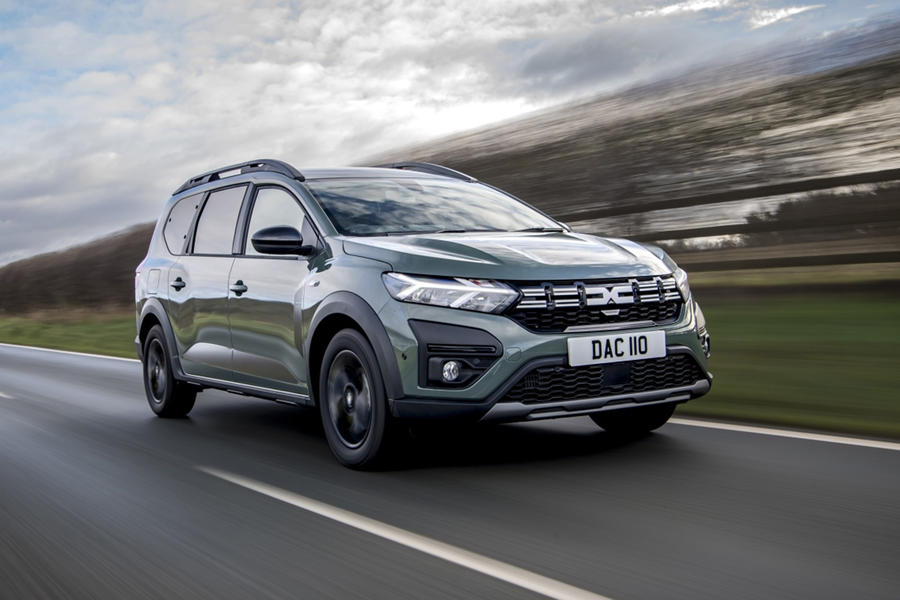
- Design8
- Interior7
- Performance7
- Ride & Handling8
- Costs10
Pros
Incredible value
Frugal mild hybrid
Charming design
Cons
Third row lacks space
Languid powertrains
Rolls in corners
Best for: Value
It’s perhaps no surprise that the biggest breath of fresh air the seven-seater has seen for a while comes from Dacia.
At just over 4.5 metres in length, the Jogger is a little shorter at the kerb than a typical C-segment MPV, but that doesn’t prevent it from offering usable passenger accommodation for up to seven.
The Dacia Jogger is a fully equipped people mover, but more importantly, it will cost you less than the price of a mainstream supermini – and is the cheapest car on this list.
Straddling the lines between estate, MPV and SUV, the Jogger contains enough space for seven adults, although the third row is best left to children on longer journeys.
With the rear seats lowered or removed completely, there’s up to 2094 litres of carrying capacity available, plus several nearly packaged storage compartments tucked away around the cabin.
Driving the Jogger is a mixed bag, but it’s not bad. There’s a supple, languid gait to its ride, while its turbocharged 1.0-litre petrol triple is a smooth and willing accomplice.
Light and accurate steering combines with a subtly raised seating position to make the Jogger easy to place on the road, and while it can roll like a drunk when cornering hard, the grip is strong and the handling always remains faithful.
It’s far from a scalpel-sharp street fighter, but there’s enough character in the way the Jogger goes about its business that it really should be considered if you’re in the market for seven seats.
Read our Dacia Jogger review
Save money with new Dacia Jogger deals from What Car?
Finance this car with Drivenfi
Latest Reviews

Mercedes-AMG E53 review
6

Hyundai Inster

Mercedes-AMG CLE 53
8

Skoda Enyaq
8

Volkswagen Tiguan
7
Read our review
Car review

Dacia Jogger
MPV and SUV tropes fuse with a compact seven-seater of likeably humble aspect
Back to top
2. Kia EV9
8

- Design8
- Interior9
- Performance9
- Ride & Handling7
- Costs9
Pros
Bold looks
Versatile interior
Long range
Cons
Feels bigger than rivals on the road
Material quality slightly short of price tag
Electric power not suited to everyone
Best for: Electric motoring
Electric cars are beginning to muscle in on the seven-seat act, and the Kia EV9 is one of the first of the bunch.
It may be all about style, impact and brand-building for its maker, but the EV9 should actually have a surprisingly rational grounding influence on the market for big electric cars.
You certainly won’t struggle to find it in a packed car park. It’s roughly the same size as the Range Rover Sport and has a really bold design, so it possesses genuine presence.
The sheer size of it and its clever packaging means it can offer six- and seven-seat cabin layouts. The former swaps the second row’s three-seat sliding bench for a pair of swivelling ‘captain’s chairs’, a bit like you would find in the Mercedes-Benz V-Class.
Those third-row seats are big enough for small adults and kids with booster seats, which is useful as four of the five rear seats get Isofix points. The rearmost seats stow and deploy electrically.
With all seats up, the boot is big enough for a reasonable amount of shopping cargo, while five-seat mode makes it very generous.
The EV9 comes with a 99.8kWh battery. In the 200hp single-motor, rear-wheel-drive model, official range is 349 miles. Kia quotes efficiency of 3.0mpkWh and our testing achieved 2.8mpkW – impressive for a car with such a large, block-like frontal area. The official range of the dual-motor, four-wheel-drive model is 313 miles.
In cooler conditions, the top-of-the-line EV9 achieved 259 miles on our 70mph touring efficiency test and gave us reason to expect it would cover a little over 300 miles in exclusively urban and gentler out-of-town motoring.
Read our Kia EV9 review
Save money with new Kia EV9 deals from What Car?
Finance this car with Drivenfi
3. Volvo XC90
8

- Design8
- Interior8
- Performance8
- Ride & Handling9
- Costs7
Pros
Roomy interior
Premium feel
Low running costs
Cons
A decade old
Not so sharp to drive
Tech starting to feel outdated
Best for: Daily driving
We think the Volvo XC90 is the best seven-seater car you can buy today.
Volvo’s passive suspension has worked wonders. There’s less pitter-patter at low speed on loose surfaces and in general it just feels like a large car, rather than an out-and-out 4×4, absorbing bumps and crests without too much float or wallow.
The fact it has been on sale for almost 10 years is a testament to its compelling blend of space, practicality, comfort and class – and a facelift looks to keep things fresh in 2025.
Some rivals are sharper to drive or offer more up-to-date tech, but the XC90 offers a great balance of performance, efficiency and low running costs, particularly for business users – especially in its plug-in hybrid form.
The XC90’s greatest strength is its roomy, well-equipped interior, which is high quality and smartly finished. It has enough space for seven adults to travel in comfort, with the third-row seats serving up good head and leg room.
The range opens with the B5 mild-hybrid petrol with 247bhp, but there’s also the refined, bik-busting T8 plug-in hybrid model, with 443bhp and 44 miles of all-electric range.
Whichever powertrain you choose, this Volvo is composed and capable on the road. Its emphasis is on comfort and refinement, rather than an uplifting driving experience, but that’s perfectly in keeping with its remit.
Read our Volvo XC90 review
Save money with Volvo XC90 deals from What Car?
Finance this car with Drivenfi
Back to top
4. Hyundai Santa Fe
8
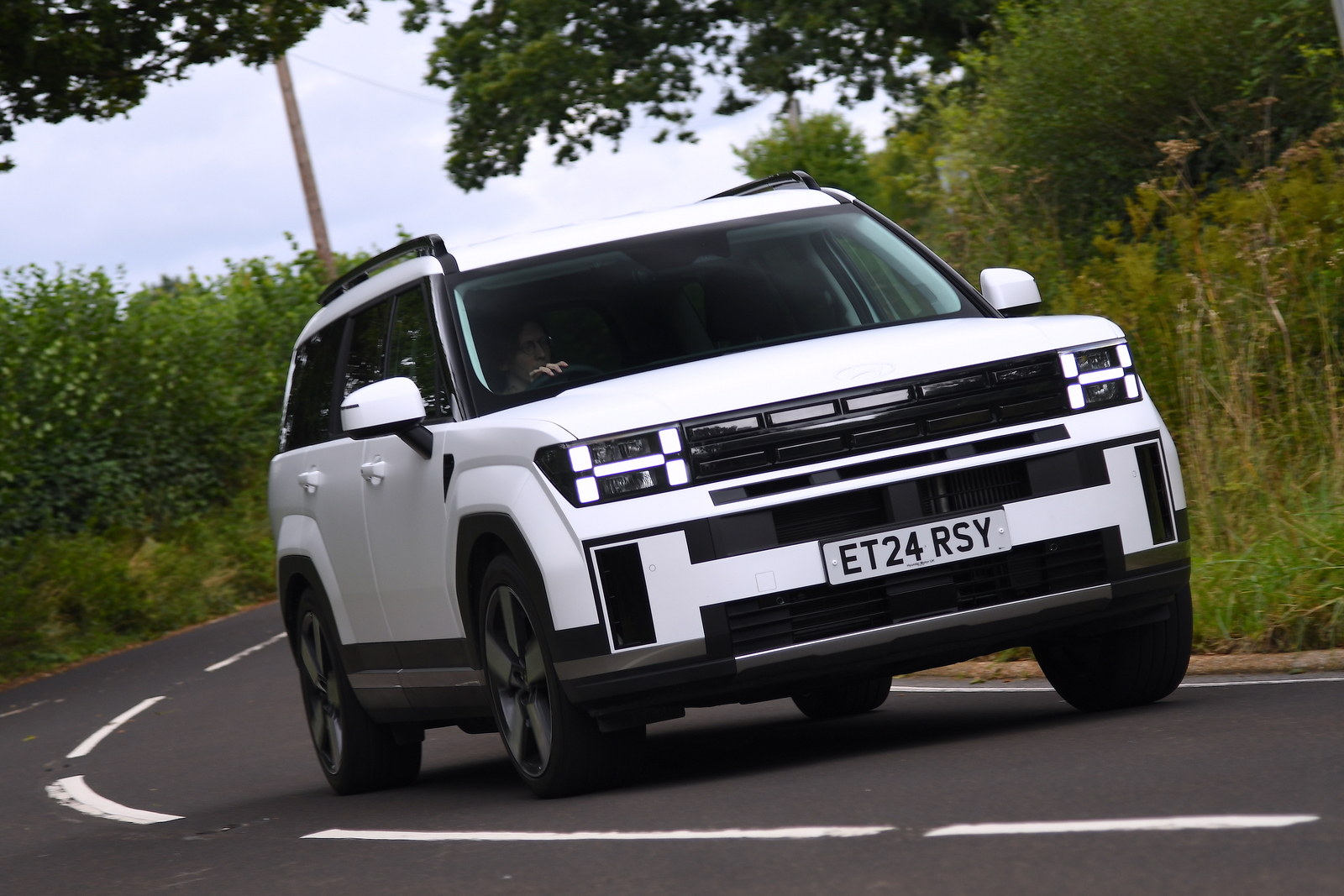
- Design9
- Interior10
- Performance6
- Ride & Handling7
- Costs7
Pros
High quality
Loads of space
Plenty of technology
Cons
PHEV is expensive and has a short EV range
It will be too big for some
Easy to switch off annoying ADAS
Best for: Interior ambience
The Hyundai Santa Fe has always been one of our favourites in the seven-seat car market, and its 2024 renewal cemented its position as a go-to option.
The interior is stylish, brilliantly practical and usable. Two small lapses, though: the offside rear side window creaked in its seals, and there’s nowhere to store the boot’s roller blind cover when using the third row of seats.
Along with a complete retro-inspired redesign, the Santa Fe is bigger and more spacious than ever, filled with technology and a comfortable way to travel with up to six passengers.
The Santa Fe comes with either a full hybrid or a plug-in hybrid powertrain, with maximum power standing at 249bhp. In PHEV guise, it offers up to 33 miles of electric-only range, which is slightly disappointing, but the rest of the car makes up for it.
Boot size varies depending on specification and powertrain, but the seven-seat PHEV features 985 litres with its rearmost seats folded down (compared with 992 litres for the regular hybrid) or 621 litres with them in place.
Partner its extensive practicality with its excellent material quality and the Santa Fe justifies its high position in our top 10.
Read our Hyundai Santa Fe review
Save money with new Hyundai Santa Fe deals from What Car?
Finance this car with Drivenfi
5. Volkswagen Multivan
8
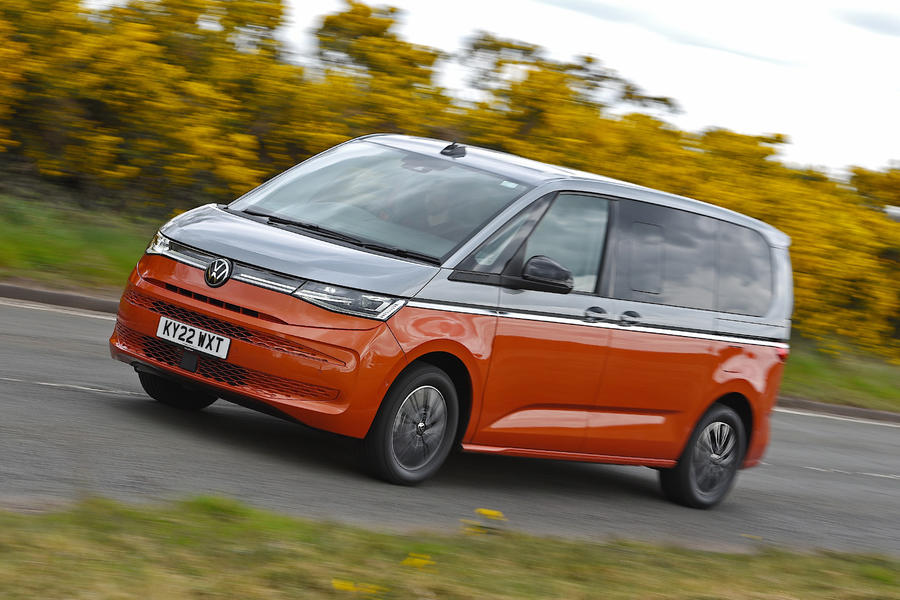
- Design8
- Interior8
- Performance7
- Ride & Handling8
- Costs7
Pros
Flexible interior
Loads of room
Great long-distance comfort
Cons
Electric-only range could be better
Relatively expensive
Fiddly infotainment system
Best for: Versatility
The Volkswagen Multivan is a traditional MPV: a thoroughly sensible and spacious box on wheels that offers unrivalled space and versatility.
This is a relaxed, easygoing cruiser with a hugely spacious and practical interior. Only because of the architecture it uses, it has all of the capability to be equipped with the latest driver and safety assistance hardware and software
A brilliantly rational form of family transport, it mixes one of the most flexible interiors in the business with grown-up driving dynamics and a dash of premium appeal.
Thanks to sitting on the MQB platform that underpins everything from the Volkswagen Golf to the Skoda Kodiaq, the Multivan also handles like a car, with surprising precision and brilliant ride refinement.
It also gets access to petrol, diesel and PHEV options. The latter uses a 1.4-litre petrol engine and an electric motor for 215bhp and a claimed 31 miles of EV running.
The Multivan’s trump card, though, is its modular interior, which can be organised just how you want it with more than enough space for seven passengers. Plus, it has a sliding door on each side.
Read our Volkswagen Multivan review
Save money with new Volkswagen Multivan deals from What Car?
Finance this car with Drivenfi
Back to top
6. Land Rover Defender 130
8
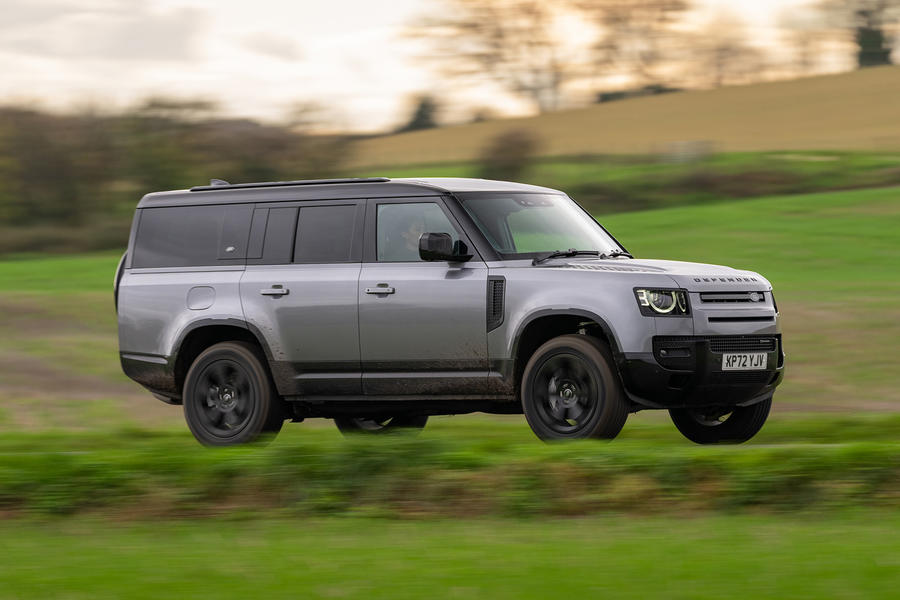
- Design8
- Interior9
- Performance8
- Ride & Handling8
- Costs7
Pros
Room for eight
Serious off-road ability
Engaging handling
Cons
Hefty price tag
Questionable reliability
It’s absolutely huge
Best for: Desirability
This biggest Land Rover Defender ought to have been a candidate for the top of this chart, because while it’s expensive, its cleverly configurable interior presents the option of as many as eight seats.
I know it’s big and tall and heavy, but it’s such a good motorway car, with great visibility, big comfortable seats, a relaxed driving position and exceptional stability and isolation, even in bad conditions.
Buy a long-wheelbase, five-door Defender 110 and JLR will offer you a choice of five, six or seven passenger seats, while the elongated Defender 130 can seat eight in a 2/3/3 formation.
Sadly, for legislative reasons, you can’t order the latter with the jump seat in between the driver and front seat passenger, which would have made it a nine-seater (and, in the UK at least, in need of registration as a minibus).
Even without this as an official option, though, this car has impressive versatility. The seven-seat Defender has third-row seats that are a little smaller than those of the related Land Rover Discovery’s but still perfectly usable by children, teenagers and smaller adults.
In the 130, you can take all eight on board and still have a very usable 400-litre boot, although the trade-off is the car’s vast 5358mm length that makes it something of a squash and a squeeze in most parking spaces.
This is also an expensive car, with even the very cheapest models starting from more than £70,000. But unlike the old Defender, it drives nearly as well as almost any luxury SUV of its size and type, has a broad range of modern electrified powertrains and has off-road capability to spare.
Read our Land Rover Defender 130 review
Save money with new Land Rover Defender deals from What Car?
Finance this car with Drivenfi
7. Land Rover Discovery
8
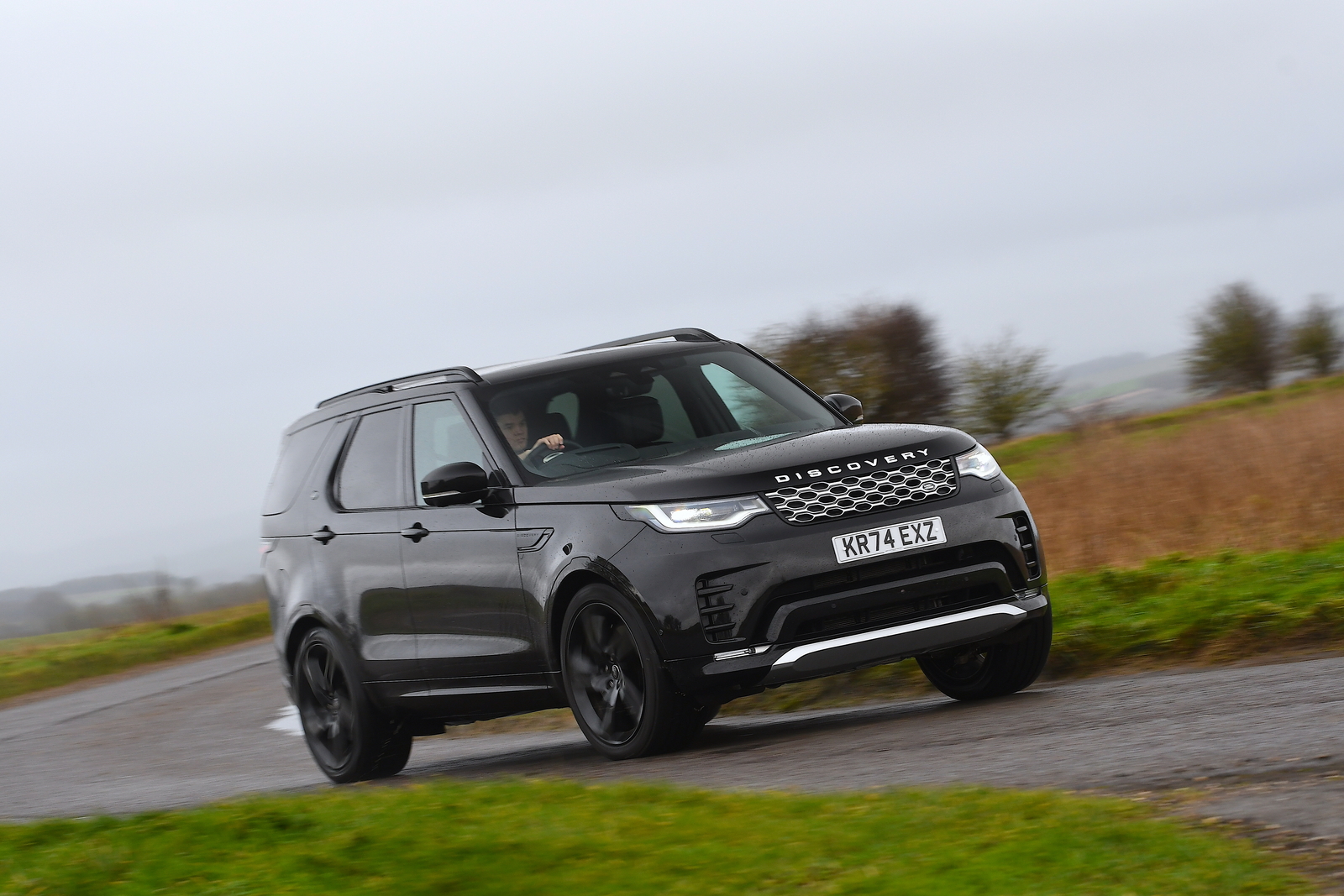
- Design8
- Interior8
- Performance8
- Ride & Handling8
- Costs7
Pros
Luxury vibes
Seven seats as standard
Roomiest third row here
Cons
Relatively expensive
Rivals more efficient
Electrically folding seats aren’t standard
Best for: Third-row space
The third-generation Land Rover Discovery remains a fine, full-sized seven-seater option, thanks to likeable charm and genuinely luxurious characteristics.
The Discovery is a proper Land Rover: modernised, refined and as likeable as ever
Launched in 2017 and updated in 2021, it comes with seven seats as standard. It’s seriously spacious, with excellent head and leg room for all passengers, and vitally it tops the list for third-row space.
Boot space stands at a cavernous 1137 litres when you’re using only five seats, but it drops down to 258 litres when using all seven.
Currently, the Discovery is only available with a mild-hybrid diesel engine, offering 348bhp and a 0-62mph sprint of 5.9sec. Apart from the Defender, then, the Discovery is probably your best bet on this list for performance.
It’s pleasant inside too – not far from Range Rover quality. And it’s even better off-road – not that the vast majority of owners will ever find out.
Read our Land Rover Discovery review
Save money with new Land Rover Discovery deals from What Car?
Finance this car with Drivenfi
Back to top
8. Skoda Kodiaq
8

- Design7
- Interior8
- Performance8
- Ride & Handling7
- Costs8
Pros
Efficient seven-seat packaging
Great value for money
Flexible diesel engine
Cons
Firm ride
Slightly misjudged handling
Cabin could be plusher
Best for: PHEV range
Skoda branched out into the seven-seat SUV market in 2016, launching a car that split the difference between full-sized and mid-sized options quite cleverly.
Despite some evidence of cost-cutting and an interior that isn’t quite the resounding success we thought it was, the Kodiaq strikes all the chords it needs to play. Even in base SE trim, it’s equipped with everything it needs.
The Kodiaq, now in its second generation, has a big cabin and a generous boot for a car of its price and size, and all versions of it bar the bottom-rung variant get seven seats as standard.
The one dimension in which the car is lacking a bit of space is cabin width, and because the middle second-row seat can’t be slid into an offset position relative to both outer ones, it’s tricky to get three child seats installed side by side.
The Kodiaq’s engine range consists of a 1.5-litre turbocharged petrol with mild-hybrid assistance and a 2.0-litre diesel.
Both are admirable units, but it’s a shame the PHEV powertrain is available only in the five-seater, especially with its impressive 70-mile EV-only range.
All Kodiaqs are pleasant and easy to drive, if a little bit firm-riding in some editions.
Read our Skoda Kodiaq review
Save money with new Skoda Kodiaq deals from What Car?
Finance this car with Drivenfi
9. Volkswagen Tayron
8

- Design8
- Interior7
- Performance7
- Ride & Handling8
- Costs7
Pros
Vast range of powertrains
Great electric-only range on the PHEV
Spacious and easy to drive
Cons
Third row space is tight
Unexciting to drive
PHEV is five-seat only
Best for: Powertrain selection
Volkswagen is no stranger to seven-seaters.
It’s easily the best in its class to drive and particularly comfortable when fitted with the adaptive dampers, but it offers less space and creature comforts in the third row.
The brand also offers the Multivan (also on this list) on sale now, while the Tiguan Allspace was the sole seven-seat offering in the brand’s passenger car division until it went out of production last year.
The Tayron is the Tiguan Allspace’s replacement. With up to seven seats, it’s available with a huge range of powertrains including petrol, diesel, mild hybrid and plug-in hybrid.
It’s a good all-around option with accessible driving dynamics, a pleasant interior and frugal powertrains, but that third row will be very tight for anybody beyond secondary school.
And like the Skoda Kodiaq, the PHEV, which boasts a 70-mile electric-only range, is not available with seven seats.
Read our Volkswagen Tayron review
Save money on a new Volkswagen Tayron with What Car?
Finance this car with Drivenfi
Back to top
10. Mercedes-Benz GLB
7

- Design8
- Interior7
- Performance7
- Ride & Handling8
- Costs7
Pros
Comfortable
Tidy handling
Plenty of interior space
Cons
Unrefined diesel engines
Ride let down by hatchback underpinnings
Struggles in quicker corners
Best for: Being fashionable
Mercedes has adopted an interesting design strategy with its new smallest SUV: to miniaturise much of the visual DNA of its largest (the GLS) and also to squeeze in seven seats as standard into a vehicle small enough that you probably wouldn’t expect to find them.
The GLB is smart looking and practical but its identity feels stretched at times
Both factors might just help to sell the car in an increasingly crowded market. The GLB is available as a 200 petrol, 200d diesel, 220d diesel or AMG 35 petrol that borrows its 302bhp turbocharged 2.0-litre four from the AMG A35 hot hatch.
Even the base petrol engine serves up ample performance for what’s a fairly laid-back-feeling car on the road, with ride quality being impressive on adaptive dampers and body control a little soft and permissive but still good.
The four-wheel-drive 4Matic models are also impressive off-road, rivalling the Land Rover Discovery Sport for go-anywhere ability.
Finally, Mercedes has broadened the GLB’s appeal with an electric EQB version, which retains the option of seven seats.
That’s available in 225bhp EQB 300 and 288bhp EQB 350 guises, both with a dual-motor, four-wheel-drive set-up. It’s comfortable and easy to drive, but with prices starting at just over £55,000, it’s not cheap, while a range of up to 257 miles falls well behind cheaper, albeit five-seat, rivals.




